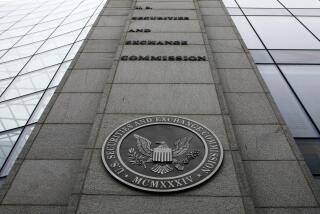SEC Faults Brokers on Limit Orders
- Share via
Many brokerages fail to promptly display customer orders that could improve the prevailing stock price, suggesting investors may not be getting immediate access to many of the best possible prices, a Securities and Exchange Commission report found.
The report, by the SEC’s inspections staff, also found these practices often go undetected and unpunished because of lax oversight by stock and options markets.
Securities firms and the exchanges both need to increase automation of procedures involving limit orders, which are placed by customers at specified prices rather than to trade at the market price, the 26-page report said. Many dealers on the Nasdaq Stock Market handle all limit orders manually, the report said.
The report found that four large dealers regularly violated SEC rules on limit-order display, including one firm that mishandled 92% of the orders sampled by inspectors. The three other firms improperly displayed between 26.5% and 58% of the orders reviewed, it said.
“This strongly suggests a pattern of neglect, serious neglect, among some market participants [in] surveillance and compliance efforts,” SEC Chairman Arthur Levitt said. He called on brokerages and exchanges “to redouble efforts” to improve procedures.
Some exchanges do no monitoring of brokerages’ limit-order display, relying only on customer complaints, the report said. At one regional stock exchange, one out of six limit orders wasn’t being properly displayed, it said.
Continued violations of limit-order rules might be referred for investigation to the SEC’s enforcement division, the report said. The SEC’s economic-analysis unit is conducting a broader study of limit-order display.
The report, which also was written by the SEC’s economic analysis office, was based on March and April inspections of regional and national stock markets, options exchanges and dealers on Nasdaq. It didn’t identify any of the offending firms or exchanges, quantify the extent of the violations, or attempt to estimate their financial impact on investors.
Limit orders account for two-thirds of all orders placed on the New York Stock Exchange and Nasdaq. These investor orders, which interact with orders placed by dealers and institutions, can equalize access between dealers and investors, the report noted.
“But in order to level the playing field, the dealers must actually display the limit orders they receive,” the report said.
Dealers and specialists have 30 seconds to display limit orders that improve on the market price. If they don’t display them, they are supposed to either execute the orders or refer them to another market for display.
The most typical brokerage violations found were failure to display orders within 30 seconds, to post the proper order size, and to properly transfer the order to another exchange, the report said.
Both the NYSE and Nasdaq have proposed ways to broaden public display of pending limit orders, which have been an important vehicle for promoting price competition in the last few years. Since they were begun on Nasdaq in 1997, these orders have narrowed trading spreads--the difference between the buying and selling prices--by about 30%.
More to Read
Inside the business of entertainment
The Wide Shot brings you news, analysis and insights on everything from streaming wars to production — and what it all means for the future.
You may occasionally receive promotional content from the Los Angeles Times.










